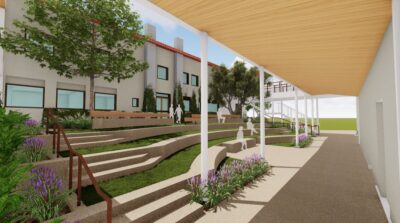
On this page:
Matching Challenge
Help us cross the finish line!
The PCM community has a special opportunity to double their investment and help close out our $11M Common Ground capital campaign.
Thanks to longtime supporters June and Simon Li, Jerry and Terri Kohl, and Karen Hillenburg, gifts to the campaign will be matched dollar for dollar, up to $500,000. We have made great strides towards meeting the match and now, to cross the finish line, we need to raise $150,000 by October 31, coinciding with the anticipated completion of the administrative wing.
Catch a sneak peek at our progress so far and sign up for a hard hat tour.


Help us raise $150,000 by October 31
To learn more about how you can support Common Ground contact our Director of Development, Melissa Froehlich.
Email: mfroehlich@pasadenaconservatory.org
Phone: (626) 683-3355 ext. 107.

PCM’s Common Ground campaign will raise $11 million to create new classrooms and performance spaces that will:
- Expand multicultural programming to include music traditions from around the world
- Expand programming in Adult Studies, Young Musicians, and Music Technology
- Develop intergenerational programming for the youngest and oldest in our community
—June Li, Board Member

Quick Facts




—Stephen McCurry, Executive Director
Timeline
-
Spring 2020
Architectural Concept Designs and Estimates
-
Summer 2021
Fundraising Efforts Commence
-
Summer 2022
Schematic Design Phase
-
Winter 2022
Design Development
-
Spring 2023
Construction Documents, Permitting Process
-
Winter 2024
Break Ground and Begin Construction
-
Spring 2025
Complete Construction

Building Plans
Team
Architect – Architectural Resources Group
Landscape Architect – EPT Design
Structural Engineer – Structural Focus
Civil Engineer – KPFF
Mechanical, Electrical, Plumbing Engineer – AEI Affiliated Engineers
Acoustical Consultant – Salter
Theater Consulting and Audio System Design – Auerbach Pollock Friedlander
Hardware Consultant – Finish Hardware Technology
Code Consultant – Jensen Hughes
Specifications Consultant – Stansen Specifications
Security and Low-Voltage Consultant – Plannet
Geotechnical Engineer – ENGEO Incorporated
General Contractor – Morley Builders


A Brief History of PCM
Roots
Beginning in the 19th century — The field of community arts and music education emerged from the settlement houses of the 1880s and 1890s. Settlement houses provided programs helping newly arrived immigrants adjust to their new country. Many were committed to providing arts programming for immigrant children. The most famous of these was Hull House in Chicago founded by Jane Addams. Some community music schools still bear the word “settlement” in their names (Cleveland, Philadelphia, Third Street NYC). Over time, the field expanded and grew more professionalized. Today, there are hundreds of community arts schools in the US, including PCM.
Mt Olive Lutheran Church
1984–1991 — Two piano teachers, Silke Sauppe and Wynne Stone, founded PCM in 1984, renting space from a small church on Allen Avenue where Sauppe was the organist. Stone visited numerous community music schools around the country to prepare for launching PCM. The eight founding instructors supplied remarkable musical and pedagogical gravitas in Western Classical Music (the school’s core), and soon enrollment grew to 400 students.
Atchison Street
1991–2001 — After eight years, the time had come to find a new home and to change the co-founder model. In September 1991, PCM moved to a rented house on Atchison Street. Soon after, an outside Executive Director was hired. In the ensuing decade, programs expanded, enrollment grew to 1,000, and an additional space was rented. It was time for the board to find a permanent home for the school.
100 North Hill Avenue
2001–2011 — In 2000, PCM launched its first capital campaign. Music Matters raised $3 million and allowed the school to acquire a permanent home. In September 2001, PCM moved to 100 North Hill Avenue in central Pasadena. In preparation for accreditation, a more formal instructional structure was introduced, including the creation of discrete program departments led by appointed department chairs (piano, strings, guitar, etc.). The preschool music program (Young Musicians) and music history/appreciation courses for adults (introduced in 2006) were stand-out bookends for the breadth of programs. Enrollment expanded to 1,200. Accreditation was achieved in 2008.
130 North Hill Avenue
2011–2021 — In 2010, PCM launched its second capital campaign. Milestones raised $8 million and enabled the school to acquire the adjacent property at 130 North Hill and implement significant renovations to the facilities at 100 North Hill, including the creation of PCM’s signature performance venue Barrett Hall. The Jazz Studies Department was launched in 2012 to attract new constituencies. Accreditation was renewed in 2014. A discrete Adult Studies Department was launched in 2018. Mariachi Pasadena! was introduced in 2019 as a first step to eventually creating a World Music Department. Enrollment grew to a high of 1,500. In March 2020, the Covid-19 pandemic closed the campus and suspended many ensemble-based programs. PCM shifted to virtual programs and operations.
Next Steps
2021 and into the future — Our current priorities include rebuilding programs suspended or diminished by the pandemic and resuming the next phase of the campus development masterplan. In the summer of 2021, PCM launched its third capital campaign. Common Ground aims to raise $11 million, to create a new learning center and outdoor amphitheater. A highlight of the new learning center is the creation of purpose-built spaces for group and ensemble programs, including young musicians classes, adult ensembles, world music ensembles, and a music technology lab—all priorities in the school’s plans to expand the breadth and depth of its offerings.